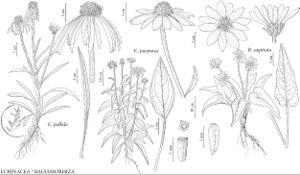Balsamorhiza
Trans. Amer. Philos. Soc., n. s. 7: 349. 1840.
| Taxon | Illustrator ⠉ | |
|---|---|---|
 | Echinacea pallida Echinacea purpurea Balsamorhiza sagittata | John Myers John Myers John Myers |
 | Balsamorhiza rosea Scabrethia scabra subsp. scabra Wyethia mollis | John Myers John Myers John Myers |
Perennials, 10–45 (–100) cm (taproots slender or massive, thick or thin-barked; caudices unbranched or multibranched). Stems erect, branched mostly from bases. Leaves mostly basal; opposite or alternate; petiolate (bases persisting as fibrils); blades (mostly pinnately nerved, sometimes 3-nerved or 5-nerved) either rounded-deltate to triangular-deltate with bases sagittate or cordate to truncate and margins entire or crenate (B. subg. Artorhiza), or blades mostly elliptic, ovate, or lanceolate to lanceovate or oblong and often 1–2-pinnatifid or pinnately lobed with bases mostly truncate to cuneate and (if not lobed) margins usually crenate, dentate, or serrate, seldom entire (B. subg. Balsamorhiza), faces usually hirsute, hispid, pilose, puberulent, scabrous, sericeous, strigose, tomentose, or velutinous and glanddotted or stipitate-glandular, seldom glabrous. Heads radiate, usually borne singly, rarely (2–3+) in ± corymbiform to racemiform arrays (peduncles ± scapiform, usually bearing 2+ leaves or bracts proximally or at mid length). Involucres mostly campanulate or turbinate to hemispheric, 11–30+ mm diam. Phyllaries persistent, 8–20+ in 2–3+ series (subequal to unequal, outer equaling or surpassing inner). Receptacles flat to convex, paleate (paleae persistent, conduplicate, at least at bases, chartaceous). Ray-florets 5–21+, pistillate, fertile; corollas usually yellow to orange, rarely becoming brick-red (B. rosea). Disc-florets (15–) 50–150+, bisexual, fertile; corollas yellow to orange, tubes much shorter than cylindric throats, lobes 5, ± deltate (style-branches stigmatic in 2 barely distinct lines, appendages filiform). Cypselae obscurely prismatic, weakly 3–4-angled (faces usually glabrous, strigose in some B. careyana and in B. rosea); pappi 0. x = 19.
Distribution
w North America
Discussion
Species 12 (12 in the flora).
Balsamorhiza ×bonseri H. St. John refers to a hybrid derivative involving B. sagittata and B. rosea. The plants have the habit of B. sagittata and the reddish ray corollas of B. rosea. The cypselae are hairy.
Balsamorhiza ×terebinthacea (Hooker) Nuttall and B. macrophylla var. terebinthacea (Hooker) A. Nelson refer to hybrids derived from B. hookeri × B. deltoidea.
In the key and descriptions here, “leaves” refers to basal leaves and “leaf blades” refers to blades of basal leaves, unless otherwise indicated.
Selected References
Key
| 1 | Leaves (petioles mostly longer than blades): blades rounded-deltate or deltate to triangular-deltate, bases sagittate or cordate to truncate, margins usually entire, sometimes crenate to dentate (subg. Artorhiza) | > 2 |
| 1 | Leaves (petioles mostly shorter than blades): blades mostly lanceolate, lance-elliptic, lance-ovate, linear-oblong, oblong, or ovate, often 1–2-pinnatifid or -pinnately lobed, bases usually truncate to cuneate, sometimes cordate, ultimate margins usually crenate, dentate, or serrate, seldom entire (subg. Balsamorhiza) | > 4 |
| 2 | Heads usually borne singly, sometimes 2–3+; leaves ± silvery to white, faces (at least the abaxial) sericeous, tomentose, tomentulose, or velutinous | Balsamorhiza sagittata |
| 2 | Heads 2–3+ or borne singly; leaves green, faces glabrous or finely hispidulous to hirtellous | > 3 |
| 3 | Heads usually (2–)3+, sometimes borne singly; leaf margins usually entire, sometimes crenate (to dentate near bases), faces usually finely hispidulous to hirtellous (cypselae strigose or glabrous) | Balsamorhiza careyana |
| 3 | Heads usually borne singly, sometimes 2+; leaf margins usually crenate to dentate (at least near bases), sometimes entire, faces usually sparsely hirtellous to hispidulous, sometimes glabrous (usually gland-dotted, sometimes vernicose; cypselae glabrous) | Balsamorhiza deltoidea |
| 4 | Leaf blades sometimes pinnately lobed (ultimate margins usually crenate-serrate, dentate, or serrate) | > 5 |
| 4 | Leaf blades usually 1–2-pinnatifid | > 6 |
| 5 | Leaf blades (earliest sometimes, later seldom, pinnately lobed): margins usually dentate to serrate, faces hirsutulous to scabrous (ray corollas yellow, not becoming red or chartaceous; cypselae glabrous) | Balsamorhiza serrata |
| 5 | Leaf blades (rarely pinnately lobed): margins crenate-serrate, faces finely strigose to moderately scabrous (ray corollas yellow at anthesis, becoming red, drying pinkand chartaceous; cypselae strigose) | Balsamorhiza rosea |
| 6 | Leaves grayish, silvery, or white, faces lanate-tomentose, sericeous, tomentose, or villous | > 7 |
| 6 | Leaves bright green to gray-green, faces glabrous or hirsute, hirtellous, hispid, hispidulous, pilose, piloso-hirtellous, scabrous, sericeous, strigillose, strigose, subvelutinous, or tomentose (sometimes gland-dotted as well) | > 9 |
| 7 | Leaves: faces densely sericeous; n California, s Oregon | Balsamorhiza sericea |
| 7 | Leaves: faces lanate-tomentose, tomentose, or villous; n California, Oregon, Washington | > 8 |
| 8 | Leaf blades ovate to lanceolate, 10–45 × 3–7(–10) cm (1-pinnatifid, lobes ovate to lanceolate, 20–50 × 5–25 mm), margins plane; Oregon, Washington | Balsamorhiza incana |
| 8 | Leaf blades lanceolate to linear-oblong, 10–20 × 3–6(–8) cm (1–2-pinnatifid, primary lobes lance-linear to oblong, 5–40 × 1–10 mm, margins revo-lute); n California | Balsamorhiza lanata |
| 9 | Leaf blades 30–60 cm, 1-pinnatifid or nearly so; outer phyllaries usually much surpassing inner | > 10 |
| 9 | Leaf blades 6–40 cm, usually 1–2-pinnatifid; outer phyllaries seldom surpassing inner | > 11 |
| 10 | Leaves: faces strigillose to subvelutinous or tomentose (margins not cili-ate); ray laminae 20–30+ mm | Balsamorhiza macrolepis |
| 10 | Leaves: faces scabrous or piloso-hirtellous to pilose (at least adaxial, mar- gins ciliate); ray laminae 35–50+ mm | Balsamorhiza macrophylla |
| 11 | Leaf blades bright green, lance-elliptic to lanceolate, (6–)15–25(–40) × (3–)5–9+ cm (primary lobes lanceolate to oblanceolate, 10–45 × 2–15 mm),faces hispidulous to hirtellous | Balsamorhiza hispidula |
| 11 | Leaf blades usually gray-green, narrowly to broadly lanceolate or ovate, (8–)20–30(–40) × 2–15 cm (primary lobes oblong or lanceolate to linear, 5–100 × 0.5–15 mm), faces hirsute, sericeous, or strigose | Balsamorhiza hookeri |
"broader" is not a number.